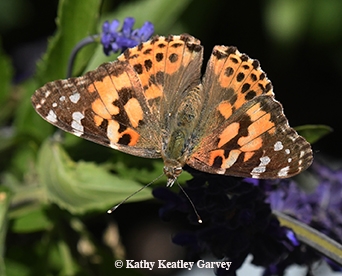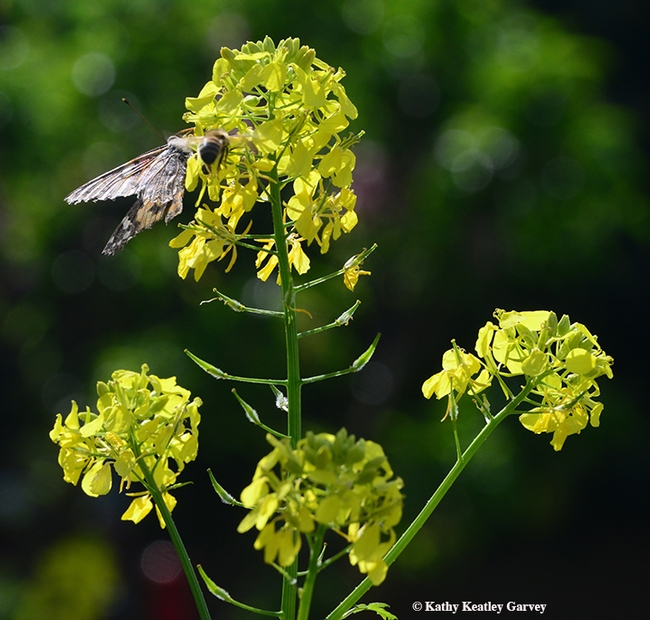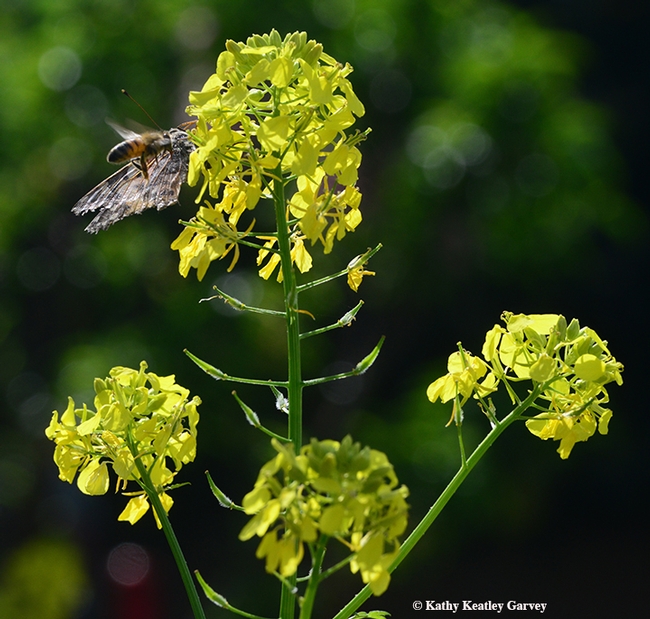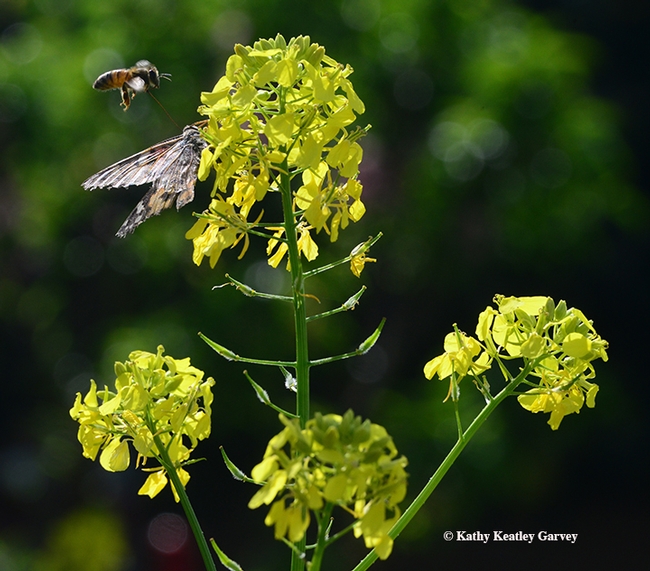
The honey bee and the Painted Lady.
Apis mellifera and Vanessa cardui.
They both wanted to sip that sweet nectar from a mustard blossom.
The Painted Lady was there first. Sometimes it's "first come, first served" and sometimes it's "I'll have what she's having."
The persistent bee managed to forage a bit around the blossom, but the butterfly, just as persistent, stayed put.
Finally, the bee buzzed over the butterfly, nearly touching it, as it headed for new territory.
Meanwhile, the cardui migration continues, from California through the Pacific Northwest. Millions have already moved through the Davis/Sacramento area on their way up north.
"It's Week 11, Day 81," says butterfly guru Art Shapiro, UC Davis distinguished professor of evolution and ecology. "It's almost over (through this area)."
An article published May 19 in the Idaho Statesman, Boise, announced that "Hundreds of Butterflies Flitted Through Boise This Weekend."
"This weekend, Boiseans found themselves in the middle of a massive migration as hundreds of orange-and-brown butterflies known as painted ladies winged their way through the area," wrote reporter Nicole Blanchard. "Dozens of people on social media shared accounts of seeing the butterflies flying overhead en masse or stopping to snack on spring blooms. Many of the painted lady butterflies, which are often mistaken for monarchs because of their orange coloring, were spotted in the North End and Foothills on Saturday."
One Boise resident related on Twitter that she saw 56 flying northwest through her yard in a period of two minutes.
Want to learn more about Painted Ladies and other butterflies? Check out Art Shapiro's website. He's been monitoring the butterfly populations of Central California since 1972.
On Vanessa carduii: The mass migration begins near the U.S.-Mexico border, Shapiro says. They breed "in the desert after the winter rains generate a crop of annual Malvaceous, Boraginaceous and Asteraceous hosts. The resulting butterflies migrate north. In good years (lots of desert rain) they may do so by billions, interfering with traffic and attracting the attention of the media. 2005 was one of the biggest Painted Lady years in history--perhaps the biggest," he says. This year was also a very good year.
"They do not stop to feed or have sex until they have burned up their reserves, carried over from the caterpillar stage," according to Shapiro. "They fly in a straight line from SE to NW, like 'bats out of Hell,' and go over obstacles rather than trying to go around them. (On certain days there may be concerted local movements in the wrong direction. We do not understand these.) Painted Ladies tend to fly parallel to the Sierra Nevada, not across it. They enter the Central Valley through the Inyo-Kern lowland or by crossing the Transverse Ranges. They can apparently make it from Bishop to Davis in three days. In some years the migration is heavier in the Great Basin and on the East slope of the Sierra than farther west. The Painted Lady moves northward in a generational wave as the season progresses. Frequently it disappears altogether from the lowlands in summer. Beginning in August the movement reverses and butterflies head south toward the desert wintering grounds. The southward migration is a more protracted affair, with plenty of adult feeding and some breeding en route. Numbers tend to be highest east of the crest, on Rabbitbrush blossoms in October."
It's been a very good year for these orange-black butterflies, which began arriving in the Davis/Sacramento area on March 17. Just don't confuse them with Monarchs! Shapiro can't begin to count the calls of folks telling him that the Monarch is no longer in trouble; that "there are millions of them!"
Attached Images:

A honey bee and a Painted Lady share a mustard blossom in Vacaville, Calif. (Photo by Kathy Keatley Garvey)

The honey bee edges closer to the Painted :ady. How sweet the nectar! (Photo by Kathy Keatley Garvey)

It's up, up and away. The honey bee buzzes over the butterfly. (Photo by Kathy Keatley Garvey)